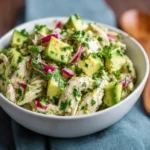Introduction
Teriyaki Chicken Stir Fry is a beloved dish that combines the savory-sweet allure of Japanese teriyaki sauce with the vibrant textures and colors of fresh vegetables, all brought together through the quick, high-heat technique of stir-frying. This meal has become a global favorite for its bold flavor profile, ease of preparation, and adaptability to various dietary preferences. Whether you’re cooking for a weeknight dinner or impressing guests at a weekend gathering, Teriyaki Chicken Stir Fry delivers both comfort and sophistication on a single plate.
The History
The roots of teriyaki trace back to Japan, where the term itself comes from two Japanese words: “teri,” meaning luster or shine, and “yaki,” which refers to grilling or broiling. Traditionally, teriyaki was a method of cooking fish—such as salmon or mackerel—by glazing it with a mixture of soy sauce, mirin (sweet rice wine), and sugar, then grilling or broiling it until the sauce caramelized into a glossy finish. The practice dates back to the 17th century, but it wasn’t until the mid-20th century that teriyaki gained international popularity.
As Japanese immigrants settled in countries like the United States, Hawaii, and Canada, they adapted their culinary traditions using local ingredients. Chicken became a popular protein in teriyaki dishes outside Japan, partly due to its mild flavor and widespread availability. Stir frying, a technique borrowed from Chinese cuisine, merged seamlessly with Japanese flavors, giving birth to what we now know as Teriyaki Chicken Stir Fry. Today, this fusion dish is a staple in Asian-inspired restaurants across North America and beyond, celebrated for its harmonious balance of sweet, salty, and umami notes.
Ingredients Breakdown
Creating an authentic yet adaptable Teriyaki Chicken Stir Fry begins with understanding each ingredient’s role in building flavor, texture, and nutritional value.
- Chicken Breast or Thighs: Boneless, skinless chicken breasts are lean and widely preferred for their clean taste and low fat content. However, chicken thighs offer richer flavor and tenderness due to higher fat content, making them ideal for those who enjoy juicier results.
- Soy Sauce: The backbone of teriyaki sauce, soy sauce provides saltiness and deep umami flavor. For a healthier option, use low-sodium soy sauce; for authenticity, opt for Japanese soy sauce (shoyu), which tends to be slightly sweeter and more balanced than Chinese varieties.
- Mirin: A sweet rice wine essential in traditional teriyaki, mirin adds subtle sweetness and helps create the signature glossy sheen. If unavailable, a mix of dry sherry and a pinch of sugar can serve as a substitute.
- Sake or Rice Vinegar: Sake enhances depth and balances sweetness, while rice vinegar can be used if sake isn’t available. Both contribute to tenderizing the meat and brightening the overall flavor.
- Brown Sugar or Honey: These natural sweeteners balance the saltiness of soy sauce. Brown sugar offers molasses undertones, while honey brings floral notes and extra gloss.
- Fresh Ginger and Garlic: Finely grated or minced, these aromatics infuse the dish with warmth and pungency, forming the aromatic foundation of the sauce.
- Vegetables: Common choices include bell peppers (red, yellow, green), broccoli florets, snap peas, carrots, mushrooms, onions, and zucchini. Each contributes color, crunch, and nutrients, enhancing both visual appeal and health benefits.
- Cornstarch: Used to thicken the sauce and help it cling to the chicken and vegetables. It also gives the sauce its velvety consistency.
- Neutral Oil: High smoke-point oils like avocado, grapeseed, or vegetable oil are ideal for stir-frying without burning.
- Sesame Oil: Added at the end for a nutty aroma and rich finish. Use toasted sesame oil sparingly—it’s potent!
- Garnishes: Sesame seeds, sliced green onions, and cilantro add freshness and visual contrast just before serving.
Step-by-Step Recipe
- Prepare the Teriyaki Sauce: In a small bowl, whisk together ½ cup soy sauce, ¼ cup mirin, 2 tablespoons sake (or rice vinegar), 3 tablespoons brown sugar (or honey), 1 tablespoon cornstarch, 1 teaspoon grated fresh ginger, and 2 cloves minced garlic. Set aside.
- Marinate the Chicken (Optional): Cut 1 pound of boneless chicken into thin strips or bite-sized pieces. Place in a bowl and pour half of the teriyaki sauce over it. Let marinate for 15–30 minutes in the refrigerator for deeper flavor (optional but recommended).
- Prep the Vegetables: While the chicken marinates, wash and slice your chosen vegetables uniformly so they cook evenly. Recommended combo: 1 red bell pepper (sliced), 1 cup broccoli florets, 1 carrot (julienned), 1 cup snap peas, and 4 oz mushrooms (sliced).
- Heat the Wok or Skillet: Place a large wok or non-stick skillet over high heat. Add 1 tablespoon of neutral oil and swirl to coat the surface evenly.
- Cook the Chicken: Remove chicken from marinade (reserve the leftover marinade). Add chicken in a single layer to the hot pan. Cook undisturbed for 2–3 minutes until golden brown on one side, then stir-fry for another 4–5 minutes until fully cooked through. Transfer to a plate and set aside.
- Stir-Fry the Vegetables: In the same pan, add another teaspoon of oil if needed. Add harder vegetables first (carrots, broccoli) and stir-fry for 2 minutes. Then add softer ones (bell peppers, snap peas, mushrooms, onions). Stir-fry for another 3–4 minutes until crisp-tender.
- Combine Everything: Return the cooked chicken to the pan with the vegetables. Pour in the reserved teriyaki sauce (and any leftover from marinating). Stir well to combine.
- Thicken the Sauce: Reduce heat to medium and simmer for 3–5 minutes, stirring frequently, until the sauce thickens and coats everything evenly. Avoid boiling too long, as over-thickening can make the sauce gummy.
- Finish with Sesame Oil: Remove from heat and drizzle with 1 teaspoon of toasted sesame oil. Toss gently to incorporate.
- Serve Immediately: Spoon the stir fry over steamed white rice, brown rice, quinoa, or cauliflower rice. Garnish generously with sliced green onions and toasted sesame seeds.
Tips
- Uniform Cutting: Cut chicken and vegetables into similar sizes to ensure even cooking.
- High Heat is Key: Stir-frying requires high heat to sear ingredients quickly, locking in moisture and creating delicious browning without overcooking.
- Don’t Crowd the Pan: Work in batches if necessary. Overcrowding causes steaming instead of frying, resulting in soggy texture.
- Prep Ahead: Mise en place (prepping all ingredients beforehand) is crucial since stir-frying happens fast.
- Adjust Sweetness: Taste the sauce before adding to the pan. Some brands of soy sauce vary in saltiness; adjust sugar accordingly.
- Gluten-Free Option: Use tamari instead of soy sauce and confirm that mirin is gluten-free (some contain barley).
- Low-Sugar Version: Replace brown sugar with a sugar substitute like erythritol or monk fruit, or reduce quantity by half.
- Extra Shine: For a restaurant-style glossy finish, increase cornstarch slightly (up to 1½ tablespoons) or brush additional warmed teriyaki sauce on top before serving.
- Reheating Tip: When reheating leftovers, do so in a pan with a splash of water or broth to revive the sauce and prevent drying out.
Variations and Customizations
One of the greatest strengths of Teriyaki Chicken Stir Fry is its versatility. Here are several creative ways to customize the dish:
- Protein Swaps: Replace chicken with thinly sliced beef (for teriyaki steak), shrimp, tofu, tempeh, or even salmon for a seafood twist.
- Vegetable Varieties: Experiment with bok choy, baby corn, water chestnuts, cabbage, asparagus, or spinach for different textures and nutrients.
- Pineapple Addition: Add chunks of fresh pineapple for a tropical flair—this classic Hawaiian variation introduces juicy sweetness that complements the teriyaki perfectly.
- Spicy Kick: Infuse heat with red pepper flakes, sriracha, or a diced chili pepper during stir-frying. You can also stir in gochujang (Korean chili paste) for complex spice.
- Noodle Version: Skip the rice and toss the stir fry with udon, soba, or ramen noodles for a heartier meal.
- Keto-Friendly: Serve over riced cauliflower or zucchini noodles and use a sugar-free teriyaki sauce made with coconut aminos and erythritol.
- Vegan Option: Use firm tofu or seitan, and ensure the mirin and soy sauce are vegan-friendly (no animal-derived additives).
- Baked Version: For a hands-off approach, marinate chicken and bake at 400°F for 20–25 minutes, then toss with sautéed veggies and sauce.
- Meal Prep Friendly: Double the recipe and portion into containers with rice for ready-to-go lunches throughout the week.
Health Considerations and Nutritional Value
Teriyaki Chicken Stir Fry can be a nutritious and balanced meal when prepared thoughtfully. Here’s a breakdown of its health aspects:
- Protein Power: Chicken breast is an excellent source of lean protein, supporting muscle growth and repair. One cup provides about 40 grams of protein.
- Low in Fat: Using skinless chicken and minimal oil keeps saturated fat low. Opt for healthy oils like avocado or grapeseed for monounsaturated fats.
- Rich in Vitamins and Fiber: Colorful vegetables supply vitamins A, C, K, folate, potassium, and dietary fiber, promoting digestive health and immune function.
- Sodium Watch: Traditional soy sauce is high in sodium. To reduce intake, use reduced-sodium soy sauce or tamari, and avoid oversaucing.
- Sugar Content: Store-bought teriyaki sauces often contain added sugars. Making your own allows control over sweetness—ideal for diabetics or those managing blood sugar levels.
- Calorie Control: A typical serving (with 1 cup rice) ranges from 450–600 calories depending on ingredients. Use brown rice or cauliflower rice to lower carbs and boost fiber.
- Antioxidant Boost: Fresh ginger and garlic have anti-inflammatory and antimicrobial properties, contributing to overall wellness.
- Allergen Notes: Contains soy and wheat (in soy sauce); easily modified with gluten-free alternatives. Always check labels if allergies are a concern.
Overall, homemade Teriyaki Chicken Stir Fry is far superior nutritionally to takeout versions, which often use excessive oil, sugar, and preservatives.
Ingredients
- 1 lb (450g) boneless, skinless chicken breasts or thighs, thinly sliced
- ½ cup soy sauce (low-sodium preferred)
- ¼ cup mirin (sweet rice wine)
- 2 tbsp sake or rice vinegar
- 3 tbsp brown sugar or honey
- 1 tbsp cornstarch
- 1 tsp freshly grated ginger
- 2 cloves garlic, minced
- 1 tbsp neutral oil (avocado, vegetable, or grapeseed)
- 1 tsp toasted sesame oil
- 1 red bell pepper, sliced
- 1 cup broccoli florets
- 1 medium carrot, julienned
- 1 cup snap peas
- 4 oz mushrooms (shiitake or button), sliced
- 2 green onions, sliced (for garnish)
- 1 tbsp sesame seeds (toasted, for garnish)
- Cooked rice (white, brown, or cauliflower), for serving
Directions
- In a small bowl, whisk together soy sauce, mirin, sake (or rice vinegar), brown sugar, cornstarch, ginger, and garlic until smooth. This is your teriyaki sauce.
- Pour half of the sauce over the sliced chicken in a bowl. Marinate for 15–30 minutes in the fridge (optional).
- While chicken marinates, prepare all vegetables and measure remaining ingredients.
- Heat a large wok or skillet over high heat. Add neutral oil and swirl to coat.
- Add chicken in a single layer; cook 2–3 minutes per side until browned and cooked through. Transfer to a plate.
- In the same pan, add a bit more oil if needed. Stir-fry carrots and broccoli first for 2 minutes.
- Add bell peppers, snap peas, mushrooms, and onions. Stir-fry 3–4 minutes until crisp-tender.
- Return chicken to the pan. Pour in remaining teriyaki sauce (including any from marinating).
- Simmer 3–5 minutes, stirring constantly, until sauce thickens and coats ingredients.
- Remove from heat. Stir in toasted sesame oil.
- Serve immediately over cooked rice. Garnish with green onions and sesame seeds.
FAQ
Can I make teriyaki sauce ahead of time?
Yes! Prepare the sauce up to one week in advance and store it in a sealed jar in the refrigerator. Shake well before using.
Can I freeze Teriyaki Chicken Stir Fry?
Yes, though texture may change slightly upon thawing. Freeze in airtight containers for up to 3 months. Reheat on stove with a splash of water.
What can I use instead of mirin?
Substitute with ¼ cup dry sherry plus 1 tsp sugar, or 3 tbsp rice vinegar plus 1 tbsp sugar. Avoid regular vinegar—it’s too sharp.
Why is my sauce too thick or too thin?
Too thick? Add a splash of water or broth. Too thin? Mix 1 tsp cornstarch with 1 tbsp cold water and stir into simmering sauce.
Is teriyaki chicken healthy?
When made at home with quality ingredients, yes. It’s high in protein and vegetables, especially when you control sodium and sugar levels.
Can I use frozen vegetables?
Yes, but thaw and drain them first to prevent excess moisture. Fresh vegetables yield better texture and flavor.
How do I get the perfect glossy finish?
The key is cornstarch and proper reduction. Simmer the sauce just until it bubbles and thickens into a shiny glaze—don’t overcook.
Summary
Teriyaki Chicken Stir Fry blends succulent chicken, crisp vegetables, and a glossy homemade teriyaki sauce for a flavorful, nutritious meal ready in under 30 minutes. Perfect for busy weeknights or elegant enough for guests, this versatile dish brings the taste of Japan right to your kitchen table.










